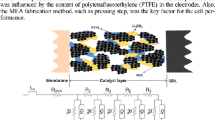Abstract
Two different molecular weight hyperbranched polymers (HBP(L)-(PA)2 and HBP(H)-(PA)2) with two phosphonic acid groups as a functional group at the periphery and a low molecular weight hyperbranched polymer (HBP(L)-(PA)2-Ac) with both two phosphonic acid groups and an acryloyl group as a cross-linker at the periphery were successfully synthesized as thermally stable proton-conducting electrolytes. A cross-linked electrolyte membrane (CL-HBP(L)-(PA)2) was prepared by thermal polymerization of the HBP(L)-(PA)2-Ac using benzoyl peroxide. Ionic conductivities of the HBP(L)-(PA)2, the HBP(H)-(PA)2, and the CL-HBP(L)-(PA)2 under dry condition and their thermal properties were investigated, and also, the effect of the phosphonic acid group number on them was discussed. Ionic conductivities of the HBP(L)-(PA)2 and the HBP(H)-(PA)2 were found to be 1.5 × 10−5 S cm−1 at 150 °C and 3.6 × 10−6 S cm−1 at 143 °C, respectively, under dry condition, and showed the Vogel–Tamman–Fulcher type temperature dependence. The hyperbranched polymers and the cross-linked electrolyte membrane were thermally stable up to 300 °C, and the cross-linked electrolyte membrane (CL-HBP-(PA)2) had suitable thermal stability as an electrolyte membrane for the high-temperature fuel cells under dry condition. Fuel cell measurement using a single membrane electrode assembly cell with the cross-linked membrane was performed.










Similar content being viewed by others
References
Kreuer KD (1996) Chem Mater 8:610
Srinivasan S, Mosdale R, Stevens P, Yang C (1999) Annu Rev Energ Environ 24:281
Steele BCH, Heinzel A (2001) Nature 414:345
Yang C, Costamagna P, Srinivasan S, Benziger J, Bocarsly AB (2001) J Power Sources 103:1
Savadogo O (1998) J New Mater Electrochem Syst 1:47
Savadogo O (2004) J Power Sources 127:135
Karlsson LE, Jannasch P (2004) J Membr Sci 230:61
Jannasch P (2003) Curr Opin Colloid Interface Sci 8:211
Wainright JS, Wang J, Weng D, Savinell RF, Litt M (1995) J Electrochem Soc 142:L121
Wang J, Savinell RF, Wainright JS, Litt M, Yu H (1996) Electrochem Acta 41:193
Schuster M, Meyer WH, Wagner G, Herz HG, Ise M, Schuster M, Kreuer KD, Maier J (2001) Solid State Ion 145:85
Schuster MFH, Meyer WH, Schuster M, Kreuer KD (2004) Chem Mater 16:329
Kreuer KD (2001) J Membr Sci 185:29
Herz HG, Kreuer KD, Maier J, Scharfenberger G, Schuster MFH, Meyer WH (2003) Electrochim Acta 48:2165
Persson JC, Jannasch P (2003) Chem Mater 15:3044
Persson JC, Jannasch P (2005) Macromolecules 38:3283
Kreuer KD, Schuster M, Paddison SJ, Spohr E (2004) Chem Rev 104:4637
Gray FM (1991) Solid polymer electrolytes: fundamentals and technological applications. VCH Publishers, New York
Scrosati B (ed) (2003) Applications of electroactive polymers. Chapman and Hall, London
Gray FM (1997) Polymer electrolytes. The Royal Society of Chemistry, London
Itoh T, Hamaguchi Y, Uno T, Kubo M, Aihara Y, Sonai A (2006) Solid State Ion 177:185
Itoh T, Hamaguchi Y, Hirai K, Uno U, Kubo M, Aihara Y, Sonai A (2006) Synthesis, ionic conductivity, and thermal properties of hyperbranched polymer with phosphonic acid groups at the chain ends for high temperature fuel cell. In: Fuller T, Bock C, Cleghorn S, Gasteiger H, Jarvi T, Mathias M, Murthy M, Nguyen T, Ramani V, Stuve E, Zawodzinski T (eds) ECS transactions, proton exchange membrane fuel cells 6, vol 3. The Electrochemical Society, Pennington, pp 113–121
Itoh T, Hirai K, Tamura M, Uno U, Kubo K, Aihara A (2008) J Power Sources 178:627
Itoh T, Ikeda M, Hirata N, Moriya Y, Kubo M, Yamamoto O (1999) J Power Sources 81–82:824
Vogel H (1921) Phys Z 22:645
Tamman G, Hesse W (1926) Anorg Allg Chem 156:245
Fulcher GS (1925) J Am Ceram Soc 8:339
Author information
Authors and Affiliations
Corresponding author
Rights and permissions
About this article
Cite this article
Itoh, T., Hirai, K., Tamura, M. et al. Synthesis and characteristics of hyperbranched polymer with phosphonic acid groups for high-temperature fuel cells. J Solid State Electrochem 14, 2179–2189 (2010). https://doi.org/10.1007/s10008-009-0947-6
Received:
Revised:
Accepted:
Published:
Issue Date:
DOI: https://doi.org/10.1007/s10008-009-0947-6




